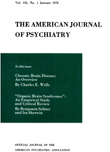ALCOHOLISM AND TRAFFIC FATALITIES: STUDY IN FUTILITY
Abstract
Of 72 drivers responsible for fatal traffic accidents in Washtenaw County, Michigan, 29 (40 percent) were alcoholic, 7 (10 percent) were prealcoholic and 36 (50 percent) were nonalcoholic. Hence one-half of the drivers had serious drinking problems of a chronic nature. Of the 46 (65 percent) drivers known to have been drinking prior to the fatal accident, 35 (75 percent) were alcoholics or prealcoholics who usually had blood alcohol levels in excess of 0.14 percent.
Many of the 29 alcoholic drivers had a long history of serious psychopathology which may well have contributed to their accident susceptibility. They were frequently paranoid(52 percent), violent(28 percent), depressed(28 percent) or suicidal (14 percent).
The records revealed that 13(45 percent) of the alcoholic drivers had at least one prior arrest for drunk driving or drunk and disorderly conduct and 16 had at one time driven with revoked licenses, including three who had no license at the time of the fatal accident. In addition, the alcoholic drivers were responsible for significantly more prior serious accidents and moving traffic violations than the nonalcoholic drivers. Two of the alcoholic drivers had killed other persons in prior traffic accidents while driving in an intoxicated state.
This investigation demonstrates that an identifiable group of alcoholic drivers was responsible for approximately one-half of the fatal accidents studied. Many serious traffic accidents are caused by alcoholic, intoxicated persons whose illness immunizes them against present deterrents. The authors believe that only a program designed to detect, restrain and rehabilitate the alcoholic driver will protect us from the "inevitabilities" which are now mislabeled "accidents."
Access content
To read the fulltext, please use one of the options below to sign in or purchase access.- Personal login
- Institutional Login
- Sign in via OpenAthens
- Register for access
-
Please login/register if you wish to pair your device and check access availability.
Not a subscriber?
PsychiatryOnline subscription options offer access to the DSM-5 library, books, journals, CME, and patient resources. This all-in-one virtual library provides psychiatrists and mental health professionals with key resources for diagnosis, treatment, research, and professional development.
Need more help? PsychiatryOnline Customer Service may be reached by emailing [email protected] or by calling 800-368-5777 (in the U.S.) or 703-907-7322 (outside the U.S.).



